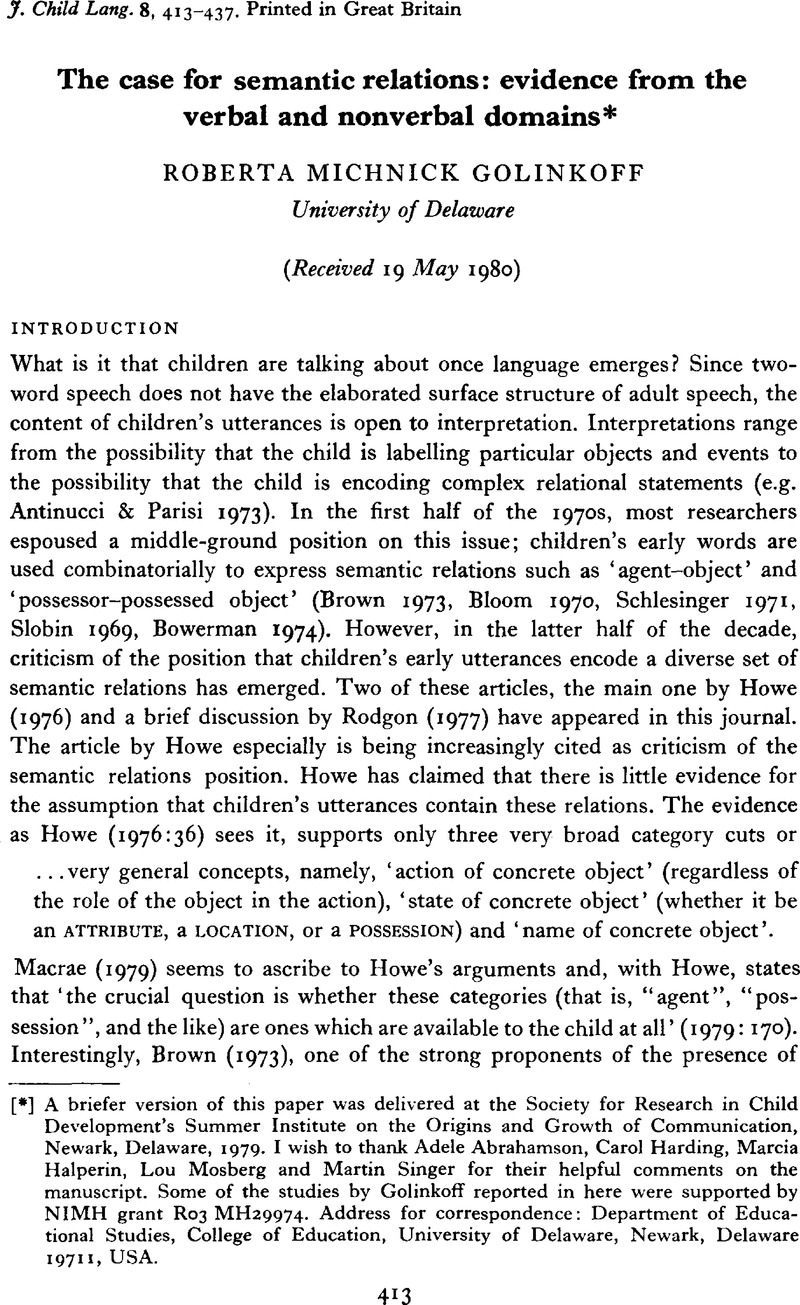Crossref Citations
This article has been cited by the following publications. This list is generated based on data provided by Crossref.
Goldfield, Eugene C.
1983.
The ecological approach to perceiving as a foundation for understanding the development of knowing in infancy.
Developmental Review,
Vol. 3,
Issue. 4,
p.
371.
Bowerman, Melissa
1983.
The Acquisition of Symbolic Skills.
p.
445.
Bloom, Lois
and
Capatides, Joanne Bitetti
1987.
Sources of meaning in the acquisition of complex syntax: The sample case of causality.
Journal of Experimental Child Psychology,
Vol. 43,
Issue. 1,
p.
112.
Golinkoff, Roberta Michnick
and
Gordon, Laura
1987.
Journal of Child Language,
Vol. 14,
Issue. 1,
p.
179.
Wijnen, Frank
1990.
The development of sentence planning.
Journal of Child Language,
Vol. 17,
Issue. 3,
p.
651.
Golinkoff, Roberta Michnick
1993.
When is communication a ‘meeting of minds’?.
Journal of Child Language,
Vol. 20,
Issue. 1,
p.
199.
Michnick Golinkoff, Roberta
and
Hirsh‐Pasek, Kathryn
2011.
Research Methods in Child Language.
p.
60.
Göksun, Tilbe
Hirsh-Pasek, Kathy
Golinkoff, Roberta Michnick
Imai, Mutsumi
Konishi, Haruka
and
Okada, Hiroyuki
2011.
Who is crossing where? Infants’ discrimination of figures and grounds in events.
Cognition,
Vol. 121,
Issue. 2,
p.
176.
Golinkoff, Roberta Michnick
Ma, Weiyi
Song, Lulu
and
Hirsh-Pasek, Kathy
2013.
Twenty-Five Years Using the Intermodal Preferential Looking Paradigm to Study Language Acquisition.
Perspectives on Psychological Science,
Vol. 8,
Issue. 3,
p.
316.
McCabe, Allyssa
Bornstein, Marc H.
Guerra, Alison Wishard
Kuchirko, Yana
Páez, Mariela
Tamis‐LeMonda, Catherine S.
Cates, Carolyn Brockmeyer
Hirsh‐Pasek, Kathy
Melzi, Gigliana
Song, Lulu
Golinkoff, Roberta
Hoff, Erika
and
Mendelsohn, Alan
2013.
Multilingual Children: Beyond Myths and Toward Best Practices and commentaries.
Social Policy Report,
Vol. 27,
Issue. 4,
p.
1.
Ünal, Ercenur
Ji, Yue
and
Papafragou, Anna
2021.
From Event Representation to Linguistic Meaning.
Topics in Cognitive Science,
Vol. 13,
Issue. 1,
p.
224.
Marklová, Anna
and
Delucchi Danhier, Renate
2023.
When spatial agency bias and the advantage of the first mention are in contradiction: Evidence from Czech, German, and Spanish.
Linguistics Beyond and Within (LingBaW),
Vol. 9,
Issue. ,
p.
76.
Nesbitt, Kimberly T.
Blinkoff, Elias
Golinkoff, Roberta Michnick
and
Hirsh-Pasek, Kathy
2023.
Making schools work: An equation for active playful learning.
Theory Into Practice,
Vol. 62,
Issue. 2,
p.
141.
Bothe, Ricarda
Eiteljoerge, Sarah
Trouillet, Leonie
Elsner, Birgit
and
Mani, Nivedita
2024.
Better in sync: Temporal dynamics explain multisensory word‐action‐object learning in early development.
Infancy,
Vol. 29,
Issue. 4,
p.
482.



